
MAY CONTAIN NUTS

Search Shorpy
SHORPY ART

Framed or unframed, desk size to sofa size, printed by us in Arizona and Alabama since 2007. Explore now.
Join and Share
Ad-Free Shorpy
Shorpy is funded by you. Patreon contributors get an ad-free experience.
Learn more.

Recent comments
- Baldwin 62303
- Baldwin VO-1000
- Cold
- No expense spared
- Tough Guys
- Lost in Toyland
- And without gloves
- If I were a blindfolded time traveler
- Smoke Consumer Also Cooks
- Oh that stove!
- Possibly still there?
- What?!?
- $100 Reward
- Freeze Frame
- Texas Flyer wanted
- Just a Year Too Soon
- WWII -- Replacing men with women at the railroad crossing.
- Yes, Icing
- You kids drive me nuts!
- NOT An Easy Job
- I wonder
- Just add window boxes
- Icing Platform?
- Indiana Harbor Belt abides
- Freezing haze
- Corrections (for those who care)
- C&NW at Nelson
- Fallen Flags
- A dangerous job made worse
- Water Stop
Member Photos
The Shorpy
Print Emporium
Print Emporium
Search Shorpy
Search results -- 30 results per page
- Portland, Maine: 1904
- ... up the mornings leaves and horse puckey. And the trolley cars filled with well dressed folks, all shaded by the mantle of those damn ... Posted by Dave - 08/21/2012 - 12:37pm -
![Portland, Maine: 1904 Portland, Maine, circa 1904. "Congress Square." 8x10 inch glass transparency (something of a novelty for this collection), Detroit Publishing Co. View full size.
Flatiron WannabeI see they added one story to the skinny building since 1904.
Getting AheadQuite a diverse lot of men's hats.
Great PhotoTransparency? I had no idea there was such. It seems to have some speed to to too. I will have to check into this! Thanks much.
[To to too? A transparency is just a copy of the original glass plate negative. Both of which are transparent. When you copy a negative you get a positive, which can then be projected as a lantern slide.- Dave]
Gotcha! Thanks much.
+104Below is the same view (looking north on Congress Street from High Street) taken in October of 2008.
Office SuppliesNow we know where the first Staples stores was, before Mr. Staples bought out his two partners.
Precious ScenariosProbably a Saturday, maybe a Sunday.The two young ladies crossing the street while horse and carriage wait between the church and the pharmacy in the "skinny building". The two young girls sitting on the curb sharing secrets while their older sister or Mom stands waiting for who knows what. The elderly gent sweeping up the mornings leaves and horse puckey. And the trolley cars filled with well dressed folks, all shaded by the mantle of those damn telephone/telegraph/electrical wires, which is about all I can see when I look out of most of windows of my apartment. As a retired photographer, I have grown to despise the early use of poles that are now too expensive to relocate to underground. Grumble.
(The Gallery, DPC, Streetcars)](https://www.shorpy.com/files/images/4a30145a.thumbnail.jpg)
- Sarasota Cyclists: 1941
- ... Oldsmobile Eight. - Dave]
(The Gallery, Bicycles, Cars, Trucks, Buses, Florida, M.P. Wolcott) ... Posted by Dave - 09/19/2019 - 6:56pm -
![Sarasota Cyclists: 1941 January 1941. "The cycle club of a Sarasota, Fla., trailer park." Medium format acetate negative by Marion Post Wolcott for the Farm Security Administration. View full size.
Pontiac?That's my best guess, but I hope someone with more expertise will identify the nifty car pulling the trailer.
[1938 Oldsmobile Eight. - Dave]
(The Gallery, Bicycles, Cars, Trucks, Buses, Florida, M.P. Wolcott)](https://www.shorpy.com/files/images/SHORPY-8c14847a.thumbnail.jpg)
- Check Coolant: 1939
- ... -- that the change was permanent.
(The Gallery, Cars, Trucks, Buses, On the Road, Russell Lee) ... Posted by Dave - 10/22/2018 - 1:23pm -
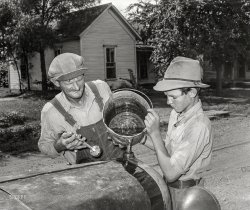
- The Buick Building: 1921
- ... (Washington Post, April 18, 1920)
(The Gallery, Cars, Trucks, Buses, D.C., Factories, Natl Photo) ... Posted by Dave - 12/05/2020 - 2:18pm -
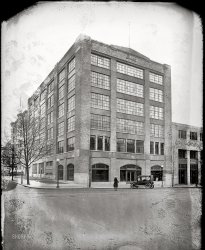
- Uncle Paul: 1957
- ... a stab at it, though.
(ShorpyBlog, Member Gallery, Cars, Trucks, Buses, Tonypix) ... Posted by Tony W. - 09/19/2011 - 2:10pm -
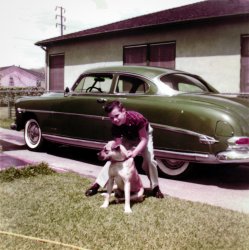
- Arkansas Travelers: 1920
- ... logo in the window above the car.
(The Gallery, Cars, Trucks, Buses, Chris Helin, San Francisco) ... Posted by Dave - 06/03/2015 - 10:36am -
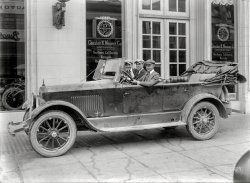
- With Both Barrels: 1937
- ... like something salvaged from an old car.
(The Gallery, Cars, Trucks, Buses, Cats, Dogs, Rural America, Russell Lee) ... Posted by Dave - 02/23/2018 - 1:30pm -
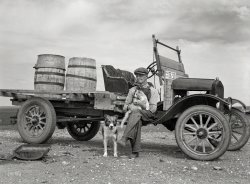
- Federal Clothing: 1925
- ... grown on the negative. -tterrace]
(The Gallery, Cars, Trucks, Buses, D.C., Stores & Markets) ... Posted by Dave - 01/16/2014 - 11:22am -
![Federal Clothing: 1925 Washington, D.C., circa 1925. "Federal Clothing Store, 621 Seventh Street N.W." National Photo Company Collection glass negative. View full size.
What's the white stuff?On the car wheels, sidewalk, and up the outside of the building.
[Mold that's grown on the negative. -tterrace]
(The Gallery, Cars, Trucks, Buses, D.C., Stores & Markets)](https://www.shorpy.com/files/images/SHORPY_32396u_0.thumbnail.jpg)
- Two Dourpower: 1919
- ... see behind the hood of the car.
(The Gallery, Cars, Trucks, Buses, Chris Helin, San Francisco) ... Posted by Dave - 10/11/2015 - 11:44am -
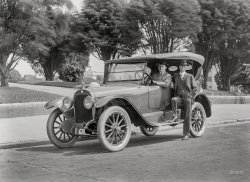
- Dearborn Street: 1907
- ... think the vehicle is a Holsman High-Wheeler. High wheeler cars were really made as rural vehicles, able to cope with high centers and ... Posted by Dave - 07/08/2015 - 12:00pm -
![Dearborn Street: 1907 1907. "Dearborn Street, Chicago." With the base of the massive Great Northern Hotel at right. 8x10 inch glass negative by Hans Behm. View full size.
Architectural giants in extreme foreshorteningOn the left-hand (west) side of Dearborn Street we can see (from left to right) slivers of the Monadnock Block (Burnham & Root, 1889-1891), the Federal Building (Henry Ives Cobb, 1905, now demolished), and the Marquette Building (Holabird & Roche, 1893-1895). The buildings shown here on the east side of Dearborn are all long gone.
Far SlotThe cable car slot in the far track that goes around the Loop hasn't been used since 1906.
High WheelerI think the vehicle is a Holsman High-Wheeler. High wheeler cars were really made as rural vehicles, able to cope with high centers and ridiculous amounts of mud; the one in the picture, though, looks to have never been on the wrong end of a cow.
Looking northThis is looking north from Adams and Dearborn. I work around here - previous comments are accurate - the buildings on the east side of this photo are long gone. Monadnock is thankfully still here, and the Marquette, while a neat building, isn't as cool as the Monadnock (in my opinion).
+100Below is the same view from April of 2007.
Paddy wagon?Could that be the tail end of a paddy wagon sticking out from the side street by the Federal Building?
[I think those are the last two letters of U.S. MAIL. similar to the sign on this wagon. -tterrace]
Great Northern HotelHere's a Shorpy photo taken four stories further up and ten years further back.
Thanks...to Bruce Lancaster for identifying the vehicle: my wife and I couldn't figure out what we were looking at. Although my wife did insist it was a car of some sort.
(The Gallery, Chicago, DPC, Stores & Markets, Streetcars)](https://www.shorpy.com/files/images/SHORPY-4a22365a.thumbnail.jpg)
- An old Pontiac?
- ... Chevy: Yes, that's definitely what it is.
(ShorpyBlog, Cars, Trucks, Buses) ... Posted by mhallack - 04/27/2009 - 6:36pm -
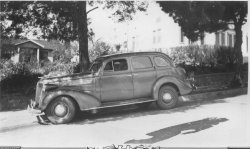
- The Bucking Buick IV
- ... looking north? Anyone else think so?
(The Gallery, Cars, Trucks, Buses, G.G. Bain, NYC) ... Posted by Dave - 09/08/2011 - 11:52am -
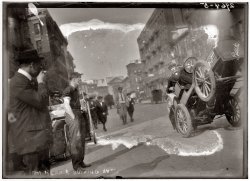
- Thoroughly Modern: 1919
- ...
[ Too late! -tterrace]
(The Gallery, Cars, Trucks, Buses, Chris Helin, San Francisco) ... Posted by Dave - 04/20/2017 - 7:02am -
![Thoroughly Modern: 1919 San Francisco circa 1919. "Velie Six touring car at Phelan mansion, Washington Street." Latest entry in the Shorpy Baedeker of Brobdingnagian Barouches. 5x7 inch glass negative by Christopher Helin. View full size.
Killer B'sIn addition to being the pun master, our host is no slouch when it comes to alliteration. I came, I saw, I consulted Google three times.
If I had a time machine... I'd go back ca. 1918 and invent windshield wipers.
[Too late! -tterrace]
(The Gallery, Cars, Trucks, Buses, Chris Helin, San Francisco)](https://www.shorpy.com/files/images/SHORPY-1138.thumbnail.jpg)
- Good for Life: 1942
- ... were the optimal times for the beverage.
(The Gallery, Cars, Trucks, Buses, Relocation Camps, Russell Lee) ... Posted by Dave - 03/23/2016 - 1:21pm -
![Good for Life: 1942 July 1942. "Nyssa, Oregon. Farm Security Administration mobile camp. Soda pop is delivered at the camp for Japanese-Americans." Medium format nitrate negative by Russell Lee for the Office of War Information. View full size.
Summer jobMy summer job for four years in high school and college was working in the local Coca-Cola bottling plant, loading and unloading trucks like this one. There were no high-loaders or lifts, it was all done manually. To load a row of cases in the top rows, you had to climb up the side of the truck and push with your foot, since the row was too heavy to push by hand (at least for me). To unload empty cases, you could usually push the row by hand, but you still had to climb the side of the truck to grab them, depending on the height of the truck and how tall you were. Then, after unloading, all the empty cases had to be sorted by hand: all the Coke bottles in separate cases, all the Pepsi bottles in others, etc. Sometimes you'd find "strange" things in a returned empty bottle, e.g., a dead mouse or a cigar. One of the job's benefits was free Coke, all you wanted, and you soon learned that not all Coke tasted the same. The best was "post mix", the syrup used in fountains, where the syrup and carbonated water were mixed on the spot. Next best was "pre mix", where the syrup and water were pre-mixed in large metal cans, for businesses, county fairs, etc. The last was regular bottled Coke. This of course was in the days when Coke contained cane sugar, not high-fructose corn sugar. I thought I had the best summer job in town.
My First Impression"How come you're not in the service, mister?"
[Answered here. -tterrace]
Glass bottles = best tasteThe oldsters among us will know that those old time glass bottles, despite their inconvenience, gave one the best burst of flavor one could receive from a bottle of soda without the metallic tones of aluminum or the chemical betrayal of plastic. I fondly recall that at large summertime picnics usually put on by community groups, religious and ethnic clubs when I was a child, we always looked forward to the individual glass bottles of frigidly cold, fruity, delightful flavors and colors seen in those huge galvanized tubs containing vast amounts of crushed ice and nestled within that ice, like jewels, were tantalizing glass bottles of vivid lime green, bright orange, red cherry, purple grape, root beer and other tempting choices to enjoy with one's hot dog or burger. Since my siblings and I were always expected to share a single quart bottle when we were at home, at these special affairs we would each get our very own and would often drink ourselves silly. There really is something sensory and unique about a crystal clear, frigid, refreshing flavor from a glass bottled beverage on an oppressively hot, sweaty summer afternoon. Just another memory from the "long-ago" that will never come again.
Soda pop is deliveredThen empties are picked up and loaded.
Before there was a dosage recommendationIn later years, Dr Pepper eliminated the 'period', and the tag line became 10 - 2 - 4.
Those were the optimal times for the beverage.
(The Gallery, Cars, Trucks, Buses, Relocation Camps, Russell Lee)](https://www.shorpy.com/files/images/SHORPY-8c32512a.thumbnail.jpg)
- Be It Ever So Humble: 1938
- ... shack, or series of shacks, mounted on railroad flat cars, to provide accomodations for the workers in the camps. The shacks would ... Posted by Dave - 02/09/2012 - 12:24pm -
![Be It Ever So Humble: 1938 November 1938. "Shack of day laborer who works in sugarcane fields near New Iberia. He comes from a parish in northern Louisiana." 35mm nitrate negative by Russell Lee for the Farm Security Administration. View full size.
Insensitive commentA set-up for a Laurel & Hardy gag if I ever saw one.
Flanged wheelsare under the hut. Fascinating.
Kids' dreamWhen I was 10 years old, this would have been just the kind of clubhouse / tree house that my friends and I would have loved to have built from scrap lumber, if only our parents would have let us construct it in the back yard.
Jug Band MusicSeeing the washboard in this picture makes me wonder if there isn't a guitar just inside the door ready for an impromptu tune.
[More likely some dirty laundry.]
On the fenceThe laundry's dryin' on the fence, Dave.
[Comment Czar - not Dave, btw - acknowledges your observation, but speculates our fellow may have separated out his whites and still needs to do his union suit.]
Early WinnebagoPrototype motor home?
About those flanged wheelsI was recently reading an article on the sawmill towns of western Louisiana. A large part of the article was devoted to the types of company housing used in the towns.
One type of housing used in the temporary logging camps [called "front camps"] was a simple shack, or series of shacks, mounted on railroad flat cars, to provide accomodations for the workers in the camps. The shacks would simply be wheeled into place on the company rail line and then withdrawn to the next location once all the timber had been cut out.
Looks like this might have been one of those "mobile homes" left over from the sawmill days, since by 1938 most of the western Louisiana timber lands were a wasteland of cut-over stumps.
(The Gallery, Agriculture, Russell Lee)](https://www.shorpy.com/files/images/SHORPY_8a24815a.thumbnail.jpg)
- Grandpa's New Tractor: 1936
- ... her age, born in 1934.
(ShorpyBlog, Member Gallery, Cars, Trucks, Buses) ... Posted by Cynnerth - 09/18/2011 - 10:01pm -
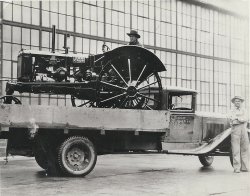
- Ghost Crossing: 1919
- ... look a whole lot different.
(The Gallery, Cars, Trucks, Buses, D.C., Kids, Natl Photo) ... Posted by Dave - 08/16/2016 - 3:20pm -
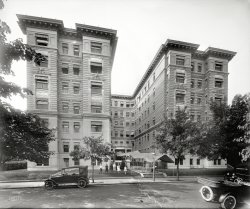
- Dressed to the Sixes: 1927
- ... would almost be a shame to hit anything.
(The Gallery, Cars, Trucks, Buses, Chris Helin, San Francisco) ... Posted by Dave - 10/19/2017 - 4:08pm -
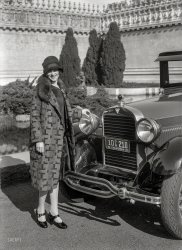
- Shuck Buddies: 1940
- ... View full size.
(The Gallery, Agriculture, Cars, Trucks, Buses, M.P. Wolcott, Rural America) ... Posted by Dave - 08/24/2019 - 3:21pm -
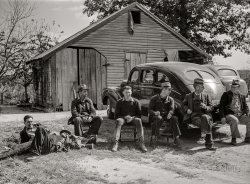
- Washington Wishbone: 1917
- ... from the Real Estate Trust Building.
(The Gallery, Cars, Trucks, Buses, D.C., Natl Photo) ... Posted by Dave - 12/15/2017 - 10:07am -
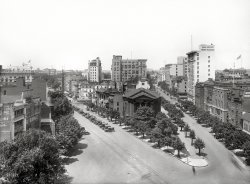
- Recon Escort: 1960
- ... greatly respected by the cadets. I liked him, too.
(Cars, Trucks, Buses, D.C., Kids) ... Posted by Dave - 12/08/2013 - 11:09pm -
![Recon Escort: 1960 August 4, 1960. "Family and mourners at the Arlington National Cemetery burial of Willard G. Palm, RB-47 reconnaissance airplane pilot shot down by the Russians." Photo by John T. Bledsoe, U.S. News & World Report. View full size.
Maj. PalmComing from a military family, myself, this one really caught my eye. I'm not finding a lot about Maj. Palm, other than about the incident which took his life. He was a WWII veteran, and that his home of record was Oak Ridge, Tennessee.
TRHalfhill, thanks for sharing your experience with Col. Olmstead! I'm glad to hear that he not only survived, but stayed in and finished his career.
This is an example of how tense things were during the Cold War. The Soviet pilot who shot the plane down admitted that it was over international air space at the time, but that he thought they intended to continue into Soviet air space.
Another tragic aspect of the event was that two of the crew members remain MIA.
Sad As It IsThe Russians had every right to do so. I mean: what would we do with a Russian "spy plane" in our airspace?
[The plane was not in Soviet airspace. - Dave]
Freeman B. OlmsteadWhen I was in college, I became acquainted with one of the survivors of that doomed RB-47 flight: Col. Freeman B. Olmstead. In the 1970s, he led the Air Force ROTC program at Kent State University in Ohio. I was a cub reporter at the student newspaper and was assigned to cover ROTC. Col. Olmstead was quite friendly and we had several interesting conversations in his office at Rockwell Hall. He didn't mention the RB-47 incident or his months as a prisoner of the Russians until one of the ROTC cadets tipped me off about it. Then Col. Olmstead told me the story and I wrote it up for the newspaper. He was greatly respected by the cadets. I liked him, too.
(Cars, Trucks, Buses, D.C., Kids)](https://www.shorpy.com/files/images/SHORPY_04373u.thumbnail.jpg)
- Death Won Here: 1940
- ... didn't start erecting them until 1979.
(The Gallery, Cars, Trucks, Buses, Russell Lee) ... Posted by Dave - 08/15/2018 - 11:09am -
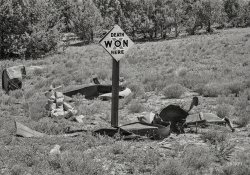
- Skeet's Cafe: 1942
- ...
Red light In the days before radios in police cars or officers on patrol carrying radios some police headquarters would turn ... Posted by Dave - 04/06/2013 - 11:55am -
![Skeet's Cafe: 1942 August 1942. "Dillon, Montana. Street corner. Dillon is the trading center for a prosperous cattle and sheep country." The cafe seen earlier here. Medium-format nitrate negative by Russell Lee for the Office of War Information. View full size.
Same motorcycle in both pics?I see that there is a motorcycle parked in almost the same spot in both pics. I wonder if the owner worked in the building, or just ate lunch there a lot.
[The two photos were taken the same day a relatively short time apart from one another. Lee had one camera loaded with black-and-white 120 roll film and another large-format camera capable of taking Kodachrome sheet film. - tterrace]
Street view?I was curious to see if I could find this building on Google Street View, but...
[See the link to the other photo in the caption; the comments to it include a Google street view. - tterrace]
Check out them dungarees!
Late '30s Harley-Davidson VLThe bike is likely a Harley VL, and it looks to be a later model (1935 or 1936) from the shape of the sheet metal.
What is it?What is the extra red light fixture on the same pole as the corner street lamp for?
Red light In the days before radios in police cars or officers on patrol carrying radios some police headquarters would turn on a light on the street and the officer would either contact or report to headquarters.
(The Gallery, Eateries & Bars, Motorcycles, Russell Lee)](https://www.shorpy.com/files/images/SHORPY_8d22381a.thumbnail.jpg)
- Gal on a Cad: 1956
- ... look into everyday life in the past.
(Member Gallery, Cars, Trucks, Buses, tterrapix) ... Posted by tterrace - 06/24/2009 - 5:12pm -
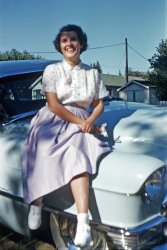
- Snellenburg's: 1912
- ... Lozier Motor Co. was located in Detroit and built luxury cars starting in 1900 and ending in 1915, when the company went bankrupt.
... Posted by Dave - 07/09/2018 - 2:59pm -
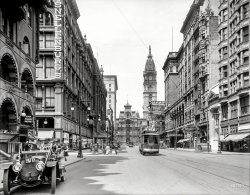
- To Grandmother's House We Go
- ... Administration.
(The Gallery, Arthur Rothstein, Cars, Trucks, Buses, On the Road) ... Posted by Dave - 12/26/2007 - 1:57pm -
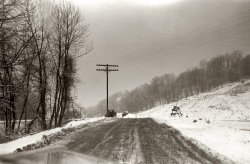
- Traffic Lighthouse: 1922
- ... Ave is a pedestrian road now :)
(The Gallery, Cars, Trucks, Buses, D.C., Harris + Ewing) ... Posted by Dave - 06/26/2014 - 10:09am -
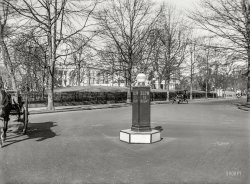
- Gas Backward: 1940
- ... of Double Cola. It’s a swell drink!
(The Gallery, Cars, Trucks, Buses, Horses, M.P. Wolcott) ... Posted by Dave - 07/16/2019 - 3:20pm -
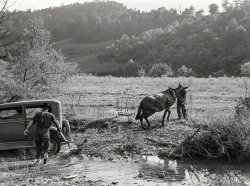
- Growth Spurt: 1912
- ... of photo just made a shove move on the four blurry box cars. The loco and 2 attached cars are only slightly fuzzy, indicating they had just about come to a stop ... Posted by Dave - 08/29/2017 - 7:16am -
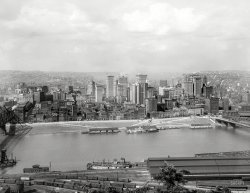
- Aerial Washington: 1911
- ... there's something I had never really thought of: street cars for freight; a forerunner of today's semi-rigs I suppose. There's one ... Posted by Dave - 04/09/2014 - 1:24pm -
![Aerial Washington: 1911 Circa 1911. "Washington from Washington Monument." Points of interest in this first installment of a six-segment panoramic view include B Street (today's Constitution Avenue), running diagonally from the Potomac Electric powerhouse at lower left; Louisiana Avenue, branching off in the general direction of Union Station at upper right; the Old Post Office and its clock tower at left-center across Pennsylvania Avenue from the Raleigh Hotel under construction; the Agriculture Department greenhouses in the foreground with a corner of the Smithsonian "National Museum" at far right, just below Center Market; Liberty Market at upper left, below what looks to be a vast tent encampment; and, at right-upper-center, the Pension Office north of Judiciary Square and the District Court House. 8x10 glass negative, Detroit Publishing Co. View full size.
"Tents"All those tents are actually slate turret roofs on top of rowhouses. Very typically, a pyramid shaped slate turret would top off the projecting bay of a DC rowhouse. All four sides would have been slated. Slate, because of its mineral content (lots of mica) can be very reflective at certain angles, hence the white appearance.
[Conical was also popular. - Dave]
SurprisingSurprising lack of motorized vehicles for ca. 1911.
[Here are seven. - Dave]
Cargo TramNow there's something I had never really thought of: street cars for freight; a forerunner of today's semi-rigs I suppose. There's one being loaded/unloaded in front of the lumber yard.
First of six?Great! Bring them on!
Kann's Busy Corneraka Kann's Department Store. A good history of the life and death of the buildings can be found here.
[More here. - Dave]
+86Below is the same view taken in December of 1997. (Please excuse my still-limited scanning talents - this was before I switched to digital.)
DC in 1911What a great photo. More of these buildings than one would think are still there. The "District Court House" south (right) of the great Pension Building on Judiciary Square is the original DC City hall, started in 1820. After a several-years-long redo, it now houses in grand style the DC Court of Appeals (the state supreme court for the District.) Peeking around the office building to the left of the City Hall on 5th Street NW is the then-new US Court of Appeals building, which housed what is now the US Court of Appeals for the DC Circuit until 1952, when it moved to the new federal courthouse on Constitution Avenue (now the Prettyman Courthouse.) The old US Court of Appeals building now houses the US Court of Appeals for the Armed Forces, on which I am privileged to sit. It is an exquisite little building, quite well-preserved, with many of its original furnishings.
Ford's TheaterI had a thought that Ford's Theater was off in this general direction, so I took a look. Not being all that familiar with D.C. I'm wondering if that is the peak of the theater with porthole just above the scaffolding atop the hotel under construction.
(The Gallery, D.C., DPC, Railroads, Stores & Markets, Streetcars)](https://www.shorpy.com/files/images/SHORPY_4a10391a.thumbnail.jpg)























